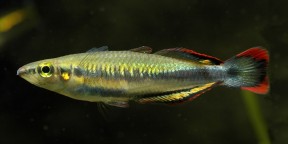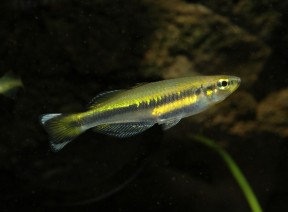Bedotia madagascarensis
Madagascan Rainbow Fish
Classification
Order: Atheriniformes Family: Bedotiidae
Distribution
Known only from small streams and the lower reaches of rivers, most of which drain into a series of coastal lagoons and lakes in Atsinanana region, eastern Madagascar. Although the extent of its historical range is unclear, modern distribution extends southwards from the lower Ivoloina River, just north of Toamasina city, as far as Manambalo Creek which lies south of the town of Vatomandry.
The lakes and rivers along this stretch of coastline are connected by the Canal des Pangalanes, an artificial waterway constructed to allow boat transport throughout the natural lake system. It’s the longest man-made canal in the world, extending for some 600 km.
South of Manambalo Creek and in the middle and upper Ivoloina River this species is replaced by undescribed members of the genus, in middle and upper sections of rivers within the boundaries of its range by B. leucopteron, and north of the Ivoloina by B. longianalis.
Habitat
Inhabits clear, flowing streams at altitudes up to 30 m AMSL, and shows a preference for habitats partially or completely shaded by riparian vegetation where water flow is not too strong. All habitats are characterised by extremely soft freshwater, and it has also been collected from blackwater swamp habitats with low pH and tannin-stained water. In unshaded or turbid environments it’s replaced by introduced Gambusia holbrooki and Xiphophorus maculatus.
Young specimens have been observed to congregate in shallow, marginal zones with adults preferring deeper water, and is normally found in groups of ‘up to several dozen’ (Loiselle and Rodriguez, 2007). The species is also fished for food across the majority of its range.
Maximum Standard Length
80 – 100 mm.
Aquarium SizeTop ↑
Unless maintaining it in smaller quarters for breeding purposes, an aquarium with base measurements of 120 ∗ 30 cm or more is mandatory.
Maintenance
Fairly undemanding provided the water is well oxygenated and high quality is maintained though it may fail to develop optimal colouration in sparsely-decorated setups. It can look superb in a heavily-planted set-up, decorated with driftwood roots and branches, some surface vegetation and perhaps with a layer of leaf litter on top of the substrate.
Like many species that naturally inhabit running waters it’s intolerant to the accumulation of organic wastes and requires spotless water at all times in order to thrive. Weekly water changes of 30-50% should also be considered mandatory.
Water Conditions
Temperature: A range of 23 – 32 °C has been recorded in its natural waters during a single month.
pH: 4.5 – 7.5. Wild specimens are likely to require more acidic water then farmed fish.
Hardness: 0 – 268 ppm
Diet
Generally unfussy but feeds mainly on terrestrial insects and other invertebrates in nature, so offer regular meals of small live and frozen foods such as bloodworm, [i]Daphnia[/i] and [i]Artemia[/i] alongside good quality dried flakes and granules. If breeding the fish is a target offer plenty of live foods.
Behaviour and CompatibilityTop ↑
Undemanding and non-aggressive. Good tankmates include similarly-sized Australasian rainbowfishes, barbs, characids, peaceful cichlids and catfishes. In a Madagascan community it can be used as a dither for endemic cichlids such as Paratilapia polleni, Paretroplus menarambo, Ptychochromis oligoacanthus, etc. It’s best to avoid keeping it with other Bedotia spp. as there is a possibility of hybridisation taking place.
It’s a schooling species by nature and really should be kept in a group of at least 8-10 specimens. Maintaining it in decent numbers will not only make the fish less nervous but will result in a more effective, natural-looking display. Males will also display their best colours as they compete with one other for female attention.
Sexual Dimorphism
Adult males exhibit a markedly greater degree of ornate pigmentation in the unpaired fins than females and are more colourful in general. Females are fuller in the body, especially when gravid.
Reproduction
This species deposits its eggs in vegetation or other suitable substrate with Taxiphylum barbieri (Java moss), Ceratophyllum spp. or floating nylon mops ideal. It’s best spawned in a pair or group comprising a single male and two or three females in a tank measuring 50-60 cm long.
Females are capable of depositing several large, robust eggs per day and the adults can either be added to the spawning tank and left in place for a week or so, i.e., until the first fry are noticed, or the substrate can be checked each day and eggs removed manually. Males can be quite aggressive in their pursuit of females so keep a close eye on the fish while they’re housed in these confined surroundings, and try to provide some solid cover using large-leaved plants or wood, for example so that females can take refuge if necessary.
Incubation is 7-10 days and the fry should be offered powdered proprietary foods of an infusoria-type grade or live infusoria as a first food with Artemia nauplii introduced after a week or so. They’re very sensitive to environmental fluctuations during the initial period of life and it may be best to avoid water changes for 2-3 weeks, after which small changes can be performed with care.
NotesTop ↑
First imported for the aquarium hobby during the 1950s and continues to be misidentified and traded as Bedotia geayi, a valid congener native to the Mananjary River system, south of its natural range. In terms of external characters, the two are most easily told apart by differences in colour pattern, particularly that of the unpaired fins, and some morphometric counts.
For example, in male B. madagascarenis the central caudal rays are coloured black due to an extension of the midlateral body stripe into the caudal fin. This dark area is enclosed by silvery white or golden yellow pigmentation which is itself surrounded by a broad dark band, and the distal tips of the fin are coloured dark red or bright white. In male B. geayi the extension of the midlateral body stripe forms a distinct spot in the caudal-fin, this surrounded by a thin, hyaline border with the remainder of the fin uniformly red.
B. geayi males also possesses a red spot on the lower jaw which is absent in B. madagascarensis, and morphometric differences include head length (27.2-31.8 % SL in B. madagascarensis vs. 22.0-29.8 in B. geayi), snout length (8.0-10.2 % SL vs. 7.1-10.1), length of base of second dorsal-fin (15.9-18.7 % SL vs. 16.9-21.4), length of anal-fin base (22.3-27.2 % SL vs. 25.1-30.0), length of caudal peduncle (16.1-20.4 % SL vs. 13.9-17.7), number of anal fin rays (14-17 vs. 17-19), and number of rays in the second dorsal fin (10-12 vs. 11-14).
Wild male B. madagascarensis are polymorphic to an extent with the dorsal, anal, and caudal fins of some individuals uniformly red and black, or with the yellow pigmentation replaced by bright white. The different forms occur together in nature with the proportion of each present varying between years.
There exists a sister-group relationship between the Bedotiidae plus the Australian and New Guinean Melanotaeniidae, which may seem surprising given their respective modern-day distributional patterns. The precise origin and subsequent dispersal of the two families has been the subject of debate, with some palentologists suggesting that Madagascar’s freshwater fishes derived froma trans-oceanic dispersal during the Cenozoic Era, but the most compelling arguments currently indicate a freshwater radiation which occurred during the Mezozoic break-up of Gondwana.
References
- Loiselle, P. V. and D. Rodriguez, 2007 - Zootaxa 1520: 1-18
A new species of Bedotia (Teleostei: Atherinomorpha: Bedotiidae) from the Rianila drainage of eastern Madagascar, with redescriptions of Bedotia madagascariensis and Bedotia geayi.




August 31st, 2014 at 10:19 pm
I recently purchased 5 of these and find them very undemanding as far as food is concerned. They are really beautiful fish but a tad aggressive especially towards new introductions. Nothing lethal about them but excessively shy fish might be intimidated by them.